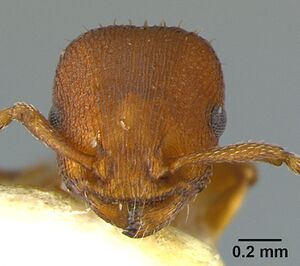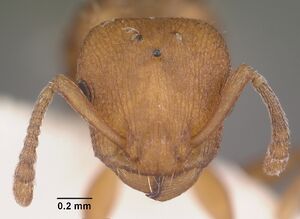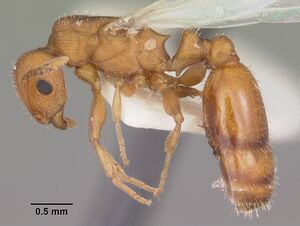Temnothorax bradleyi
| Temnothorax bradleyi | |
|---|---|

| |
| Scientific classification | |
| Kingdom: | Animalia |
| Phylum: | Arthropoda |
| Class: | Insecta |
| Order: | Hymenoptera |
| Family: | Formicidae |
| Subfamily: | Myrmicinae |
| Tribe: | Crematogastrini |
| Genus: | Temnothorax |
| Species group: | rugatulus |
| Species: | T. bradleyi |
| Binomial name | |
| Temnothorax bradleyi (Wheeler, W.M., 1913) | |
Nests are found under bark of living pine trees. They occupy flat well-defined galleries about 1 meter above the ground. A colony, believed to be complete, contained 1 dealate female, 42 workers, 2 males and brood (Wilson, 1952). These ants are sometimes attracted to peanut butter or jelly baits on tree trunks, but the nest is seldom accessible.
Identification
Prebus (2017) - A member of the rugatulus clade.
Mackay (2000) - This species has an 11-segmented antenna, the scape of which reaches halfway between the eyes and the occipital corners. The mesosoma has no evidence of a mesopropodeal constriction. The propodeal spines are stout and as long as the distance between their bases. The femora are incrassate. The head is longitudinally rugose, the intrarugal spaces are reticulopunctate. The mesosoma, petiole and postpetiole are densely punctate, the mesosoma is also reticulate and longitudinally rugose on the top and sides.
Temnothorax bradleyi is similar in color and morphology to Temnothorax smithi but the latter has propodeal spines that are shorter and have few conspicuous carinae on the side of mesosoma.
Wheeler (1913) and Wilson (1952) compared Temnothorax bradleyi to Temnothorax schaumii and Temnothorax smithi (=Temnothorax wheeleri). It is similar to Temnothorax schaumii, except it is more coarsely rugose, the propodeal spines are much larger. It is smaller than Temnothorax smithi, with a Weber's length of 0.83-0.93mm, compared to 0.90-1.13 in Temnothorax smithi The head length of Temnothorax bradleyi ranges from 0.70-0.80, whereas it ranges from 0.83-l.02 in Temnothorax smithi. The mesosoma of Temnothorax bradleyi is mostly punctate but with interspersed rugae, whereas the mesosoma of Temnothorax smithi is coarsely rugo-reticulate. Both species are a rich, ferrugineous red.
Keys including this Species
Distribution
USA. Central Florida north into Georgia, and west to Alabama and Louisiana; likely to be found in the Carolinas also.
Latitudinal Distribution Pattern
Latitudinal Range: 33.583° to 27.17533333°.
| North Temperate |
North Subtropical |
Tropical | South Subtropical |
South Temperate |
- Source: AntMaps
Distribution based on Regional Taxon Lists
Nearctic Region: United States (type locality).
Distribution based on AntMaps
Distribution based on AntWeb specimens
Check data from AntWeb
Countries Occupied
| Number of countries occupied by this species based on AntWiki Regional Taxon Lists. In general, fewer countries occupied indicates a narrower range, while more countries indicates a more widespread species. |

|
Estimated Abundance
| Relative abundance based on number of AntMaps records per species (this species within the purple bar). Fewer records (to the left) indicates a less abundant/encountered species while more records (to the right) indicates more abundant/encountered species. |

|
Habitat
Deyrup and Cover (2004) "Nests are usually in large, living pines, especially Pinus elliottii and P. palustris in open areas. A member of the longleaf pine ecosystem."
Abundance
Uncommon.
Biology
Castes
Worker
Images from AntWeb
    
| |
| Worker. Specimen code casent0105869. Photographer Dan Kjar, uploaded by California Academy of Sciences. | Owned by USNM, Washington, DC, USA. |
Queen
Images from AntWeb
    
| |
| Queen (alate/dealate). Specimen code casent0104014. Photographer April Nobile, uploaded by California Academy of Sciences. | Owned by ABS, Lake Placid, FL, USA. |
Male
Images from AntWeb
   
| |
| Male (alate). Specimen code casent0104013. Photographer April Nobile, uploaded by California Academy of Sciences. | Owned by ABS, Lake Placid, FL, USA. |
Nomenclature
The following information is derived from Barry Bolton's Online Catalogue of the Ants of the World.
- bradleyi. Leptothorax bradleyi Wheeler, W.M. 1913c: 113 (w.) U.S.A. Wilson, 1952a: 69 (q.m.). Combination in L. (Myrafant): Smith, D.R. 1979: 1392; in Temnothorax: Bolton, 2003: 271. See also: Mackay, 2000: 321.
Unless otherwise noted the text for the remainder of this section is reported from the publication that includes the original description.
Description
Worker
Head rather large, subrectangular, a little longer than broad, with straight, parallel sides and feebly excised posterior border. Eyes rather small, at lhe middle of the sides of he head. Mandibles and clypeus moderately convex, the latter with straight, entire anterior border. Frontal area small and indistinct. Antennae 11-jointed; scapes reaching half way between the eyes and the posterior corners of the head; funiculi with a 3-jointed club; first funicular joint as long as the three succeeding joints together; joints 2-6 much broader than long, joint 7 as long as broad; terminal joint longer than the two penultimate joints together. Thorax rather robust, narrower than the head, broader in front than behind, but as high behind as in front, with flattened dorsal and lateral surfaces and rather angular humeri, without any traces of a mesoepinotal constriction. Epinotal spines stout, as long as broad at their bases, laterally compressed, suddenly tapering at their tips, directed backward and slightly upward, further apart at their bases than long. Petiole from above about 1 1/2 times as long as broad, pyriform, with rounded sides; its node in profile with feebly concave anterior and decidedly convex posterior slopes, meeting with a distinct transverse ridge, the lower border in profile feebly concave and with a small, compressed anterior tooth. Postpetiole from above transversely elliptical, slightly broader than the petiole, slightly broader than long, in profile smaller than the petiole, as long as high, with evenly rounded, convex node. Gaster elongate elliptical, its sides rather straight, its anterior border excised in the middle.
Legs stout, with incrassated femora.
Head, including the mandibles, thorax, petiole, postpetiole and antennae opaque; gaster and legs shining. Mandibles finely longitudinally striated. Clypeus coarsely longitudinally rugose, on the sides reticulately rugose. Head above and on the sides finely and evenly longitudinally rugose, with the interrugal spaces reticulate-punctate. Thorax, petiole and postpetiole densely punctate, the thorax also reticulately and longitudinally rugose both on the dorsal and pleural surfaces.
Hairs yellowish, short and rather abundant, clavate and erect on the head, thorax and abdomen, appressed and pointed on the legs and scapes.
Color ferruginous red; antennae, legs and gaster, except the posterior borders of the segments, somewhat paler; mandibular teeth black.
Queen
(Wilson 1952) Alitrunk length 1.33 mm.; head length 0.86 mm.
Differing from the worker in the usual characters separating these two castes, in sculpturing, and in proportions of the propodeal spines. Mesonotal cutum and scutellum evenly flattened in profile, the posterior third of the scutellum sloping downard somewhat. The propodeal pines blunt and dentiform . Notaulices and parapsidal furrows absent.
Head covered by relatively coarse, longitudinal rugae (approximately thirty would be cut by a line drawn transversely across the center of the head); rugae variable in size, frequently anastomosing; the interspaces punctate. Central portion and collar of pronutum granulose, the pleural arms rugolreticulate, with the two zones of sculpturing meeting abruptly. Mesothoracic scutum and epipleurites with finer, more evenly longitudinal rugae (approximately forty would be cut by a line drawn transversely across the center of the scutum). Scutellum with smaller, less regular, and indistinct rugae. Anterior margin of the propodeum rugose, the remainder granulose. Sides of the alitrunk mostly granulose, with a few marginal rugae. Petiole and postpetiole with numerous shallow, confluent punctures, and a few indistinct longitudinal rugae; their surfaces feebly shining. The gaster without sculpturing, glabrous.
Male
(Wilson 1952) Alitrunk length 1.23 mm.; head length 0.52 mm. Antennae 12-jointed, with the funicular segments gradually diminishing in size distally and not forming a distinct club. Notaulices (Mayrian Furrows) present and distinct, converging directly behind the center of the mesonotum. Wings with greatly reduced venation, the following veins occurring in the forewing: Sc + R, R1, RsF1, Rs + M, Rsf5, Mf1, M +CuA, A, cu-a. Mf5, CuA, and A distad to cu-a present but faded and indistinct. In one of the two specimens examined a small crossvein (2r?) extend from Rsf5 almost to the stigma. (See Brown and Nutting, Trans. Amer. Ent. Soc., Vol. 75, pp. 113-132, for a discus ion of homology.) Hindwing with two very faint, basal abscissae. Costal, median, submedian, and cubital cells present in the fore wing; discoidal cell absent.
Most of head covered by longitudinal rugulae, the interspaces punctate, a condition approaching that of the worker; rugae of occiput indistinct, with a transverse trend. Most of the alitrunk covered by longitudinal rugulae, but these are finer and more closely set than those of head; interspace punctulation not apparent. Propodeum covered by shallow, confluent punctures. Petiole, postpetiole, and gaster shining, largely free from sculpturing. All of body except appendages jet black. Scape and femoria dark brown, funiculus and distal portion of legs light brown. Wings faintly iridescent.
Type Material
Georgia. Charlton Co.. Okefenokee Swamp. Billy's Island. American Museum of Natural History as reported in Mackay 2000.
Etymology
Patronym. Named in honor of the collector, Dr. J. C. Bradley.
References
- Bolton, B. 2003. Synopsis and Classification of Formicidae. Mem. Am. Entomol. Inst. 71: 370pp (page 271, Combination in Temnothorax)
- Colby, D. and D. Prowell. 2006. Ants (Hymenoptera: Formicidae) in wet longleaf pine savannas in Louisiana. Florida Entomologist. 89:266-269.
- Deyrup, M. and S. Cover. 2004. A new species of the ant genus Leptothorax from Florida, with a key to the Leptothorax of the southeast (Hymenoptera: Formicidae). Florida Entomologist. 87:51-59.
- MacKay, W. P. 2000. A review of the New World ants of the subgenus Myrafant, (genus Leptothorax) (Hymenoptera: Formicidae). Sociobiology 36: 265-444 (page 321, see also)
- Prebus, M. 2017. Insights into the evolution, biogeography and natural history of the acorn ants, genus Temnothorax Mayr (hymenoptera: Formicidae). Bmc Evolutionary Biology. 17:250. doi:10.1186/s12862-017-1095-8 (The doi link to the publication's journal webpage provides access to the 24 files that accompany this article).
- Prebus, M.M. 2021. Taxonomic revision of the Temnothorax salvini clade (Hymenoptera: Formicidae), with a key to the clades of New World Temnothorax. PeerJ 9, e11514 (doi:10.7717/peerj.11514).
- Smith, D. R. 1979. Superfamily Formicoidea. Pp. 1323-1467 in: Krombein, K. V., Hurd, P. D., Smith, D. R., Burks, B. D. (eds.) Catalog of Hymenoptera in America north of Mexico. Volume 2. Apocrita (Aculeata). Washington, D.C.: Smithsonian Institution Pr (page 1392, Combination in L. (Myrafant))
- Wheeler, W. M. 1913d. Ants collected in Georgia by Dr. J. C. Bradley and Mr. W. T. Davis. Psyche (Camb.) 20: 112-117. (page 113, worker described)
- Wilson, E.O. 1952a. Notes on Leptothorax bradleyi Wheeler and L. wheeleri M.R. Smith. Entomological News 63: 67-71. [19.iii.1952.]PDF
References based on Global Ant Biodiversity Informatics
- Annotated Ant Species List Ordway-Swisher Biological Station. Downloaded at http://ordway-swisher.ufl.edu/species/os-hymenoptera.htm on 5th Oct 2010.
- Colby, D. and D. Prowell. 2006. Ants (Hymenoptera: Formicidae) in Wet Longleaf Pine Savannas in Louisiana. Florida Entomologist 89(2):266-269
- Dash S. T. and L. M. Hooper-Bui. 2008. Species diversity of ants (Hymenoptera: Formicidae) in Louisiana. Conservation Biology and Biodiversity. 101: 1056-1066
- Deyrup M., C. Johnson, G. C. Wheeler, J. Wheeler. 1989. A preliminary list of the ants of Florida. Florida Entomologist 72: 91-101
- Deyrup, M. 2003. An updated list of Florida ants (Hymenoptera: Formicidae). Florida Entomologist 86(1):43-48.
- Deyrup, M. and S. Cover. 2004. A new species of the ant genus Leptothorax from Florida, with a key to the Leptothorax of the southeast (Hymenoptera: Formicidae). Floridae Entomologist 87(1):51-59
- Forster J.A. 2005. The Ants (hymenoptera: Formicidae) of Alabama. Master of Science, Auburn University. 242 pages.
- Johnson C. 1986. A north Florida ant fauna (Hymenoptera: Formicidae). Insecta Mundi 1: 243-246
- MacGown, J.A and J.A. Forster. 2005. A preliminary list of the ants (Hymenoptera: Formicidae) of Alabama, U.S.A. Entomological News 116(2):61-74
- Mackay W. P. 2000. A review of the New World ants of the subgenus Myrafant, (genus Leptothorax) (Hymenoptera: Formicidae). Sociobiology 36: 265-444.
- Van Pelt A. F. 1948. A Preliminary Key to the Worker Ants of Alachua County, Florida. The Florida Entomologist 30(4): 57-67
- Wheeler W. M. 1913. Ants collected in Georgia by Dr. J. C. Bradley and Mr. W. T. Davis. Psyche (Cambridge) 20: 112-117.
- Wilson E. O. 1952. Notes on Leptothorax bradleyi Wheeler and L. wheeleri M. R. Smith (Hymenoptera: Formicidae). Entomological News 63: 67-71.

